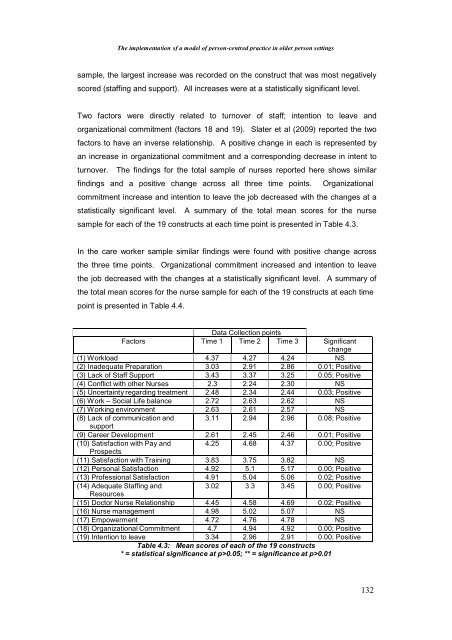The Implementation of a Model of Person-Centred Practice In Older ...
The Implementation of a Model of Person-Centred Practice In Older ...
The Implementation of a Model of Person-Centred Practice In Older ...
You also want an ePaper? Increase the reach of your titles
YUMPU automatically turns print PDFs into web optimized ePapers that Google loves.
<strong>The</strong> implementation <strong>of</strong> a model <strong>of</strong> person-centred practice in older person settings<br />
sample, the largest increase was recorded on the construct that was most negatively<br />
scored (staffing and support). All increases were at a statistically significant level.<br />
Two factors were directly related to turnover <strong>of</strong> staff; intention to leave and<br />
organizational commitment (factors 18 and 19). Slater et al (2009) reported the two<br />
factors to have an inverse relationship. A positive change in each is represented by<br />
an increase in organizational commitment and a corresponding decrease in intent to<br />
turnover. <strong>The</strong> findings for the total sample <strong>of</strong> nurses reported here shows similar<br />
findings and a positive change across all three time points. Organizational<br />
commitment increase and intention to leave the job decreased with the changes at a<br />
statistically significant level. A summary <strong>of</strong> the total mean scores for the nurse<br />
sample for each <strong>of</strong> the 19 constructs at each time point is presented in Table 4.3.<br />
<strong>In</strong> the care worker sample similar findings were found with positive change across<br />
the three time points. Organizational commitment increased and intention to leave<br />
the job decreased with the changes at a statistically significant level. A summary <strong>of</strong><br />
the total mean scores for the nurse sample for each <strong>of</strong> the 19 constructs at each time<br />
point is presented in Table 4.4.<br />
Data Collection points<br />
Factors Time 1 Time 2 Time 3 Significant<br />
change<br />
(1) Workload 4.37 4.27 4.24 NS<br />
(2) <strong>In</strong>adequate Preparation 3.03 2.91 2.86 0.01; Positive<br />
(3) Lack <strong>of</strong> Staff Support 3.43 3.37 3.25 0.05; Positive<br />
(4) Conflict with other Nurses 2.3 2.24 2.30 NS<br />
(5) Uncertainty regarding treatment<br />
(6) Work – Social Life balance<br />
2.48<br />
2.72<br />
2.34<br />
2.63<br />
2.44<br />
2.62<br />
0.03; Positive<br />
NS<br />
(7) Working environment 2.63 2.61 2.57 NS<br />
(8) Lack <strong>of</strong> communication and<br />
support<br />
3.11 2.94 2.96 0.08; Positive<br />
(9) Career Development 2.61 2.45 2.46 0.01; Positive<br />
(10) Satisfaction with Pay and<br />
Prospects<br />
4.25 4.68 4.37 0.00; Positive<br />
(11) Satisfaction with Training<br />
(12) <strong>Person</strong>al Satisfaction<br />
3.83<br />
4.92<br />
3.75<br />
5.1<br />
3.82<br />
5.17<br />
NS<br />
0.00; Positive<br />
(13) Pr<strong>of</strong>essional Satisfaction 4.91 5.04 5.06 0.02; Positive<br />
(14) Adequate Staffing and<br />
Resources<br />
3.02 3.3 3.45 0.00; Positive<br />
(15) Doctor Nurse Relationship 4.45 4.58 4.69 0.02; Positive<br />
(16) Nurse management<br />
(17) Empowerment<br />
4.98<br />
4.72<br />
5.02<br />
4.76<br />
5.07<br />
4.78<br />
NS<br />
NS<br />
(18) Organizational Commitment<br />
(19) <strong>In</strong>tention to leave<br />
4.7<br />
3.34<br />
4.94<br />
2.96<br />
4.92<br />
2.91<br />
0.00; Positive<br />
0.00; Positive<br />
Table 4.3: Mean scores <strong>of</strong> each <strong>of</strong> the 19 constructs<br />
* = statistical significance at p>0.05; ** = significance at p>0.01<br />
132
















